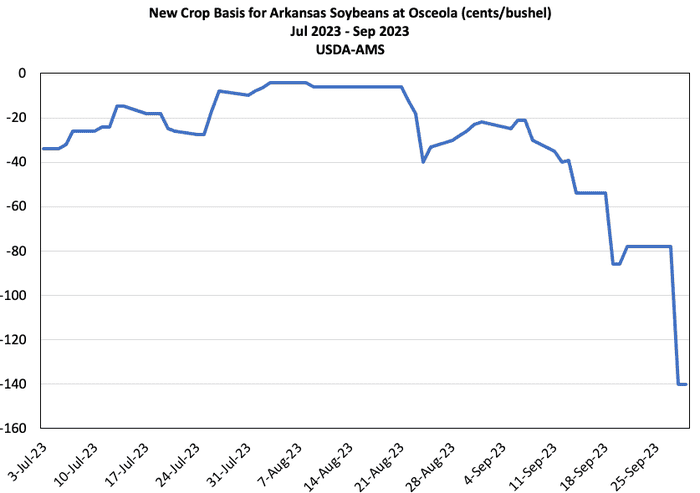
A recent supply chain disruption is impacting grain markets Low water levels on the Lower Mississippi River are disrupting the grain markets due to transportation costs, and crop prices. This issue draws on familiar economic concepts that we used to describe the pandemic-induced shocks to beef processing.

The Lower Mississippi River is historically low. The graph above shows stream gauge measurements from the U.S. Geological Survey monitoring station in Memphis, Tennessee. Gage height is a relative measurement of water level and anything below -5 feet is classified as Low Stage. At -12 feet, measurements are no longer reliable. The most recent data shows the Mississippi River at -11.80 feet at the Memphis monitoring station.
When the Mississippi River is low, it becomes more costly to ship grain by barge. At some point, it becomes unsafe, and barge traffic stops completely. As it becomes more expensive to ship grain by barge, grain elevators will bid down grain prices. If the Mississippi River is closed to barge traffic, grain elevators might stop buying grain if storage is maxed out. It is particularly problematic for farms in states like Arkansas, where most soybeans are shipped by barge for export markets. The graph below shows new crop basis (cash minus November futures) for Arkansas soybeans.

Low water levels on the Lower Mississippi River raise the issue of capacity. When the Mississippi River is low, there is an incentive to store grain. If storage capacity is maxed out, then grain bids will decline to reflect lower derived demand for grain. Other grain elevators can’t absorb the shock because they will have limited (if any) excess capacity. As such, grain bids will be lower at most all grain elevators.
There is also the issue of transportation and diverting grain to other markets. One alternative would be to move grain using different modes of transportation, including truck and rail. This could be a viable option, but grain prices will reflect the cost of transportation. Moreover, grain prices will decline as more is diverted to these alternative markets other than the river market. For this to work, these different modes of transportation would need the capacity to divert significant quantities away from the Mississippi River.
There are a lot of similarities between the current issue facing grain markets and beef markets as of the last few years. The most apparent similarity is this concept of capacity. For beef, it was processing capacity. For grain, it is storage capacity. And processing if the conversation is about crush facilities. It will be interesting to be part of conversations about this topic during this year’s Winter Production meetings.
About the Author(s)
You May Also Like




